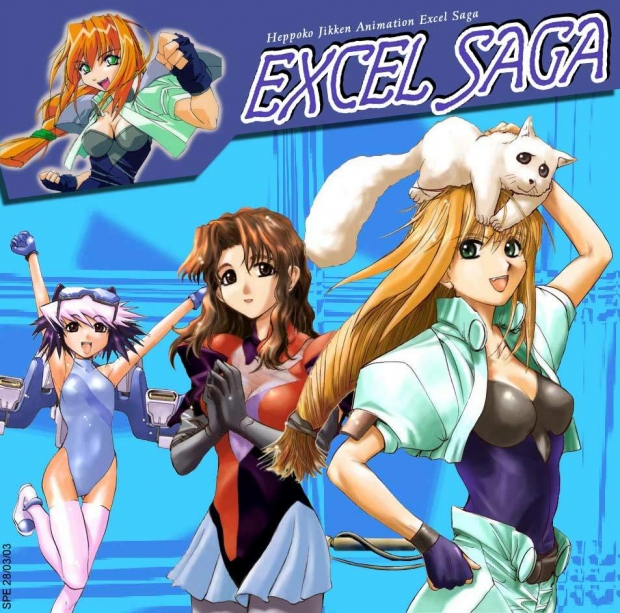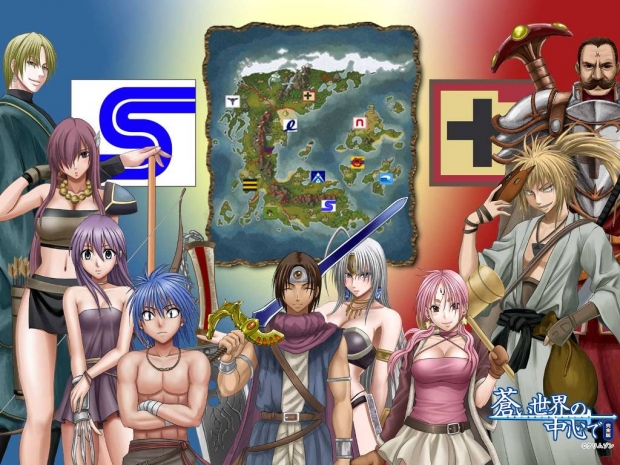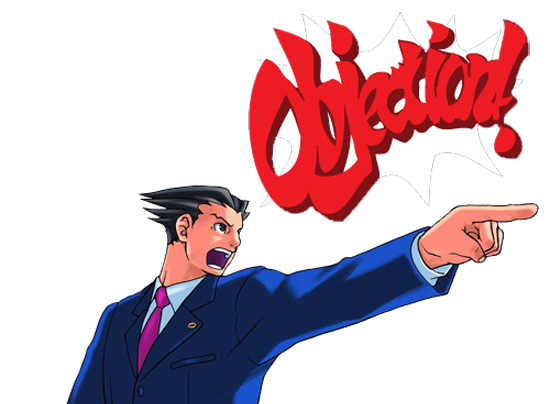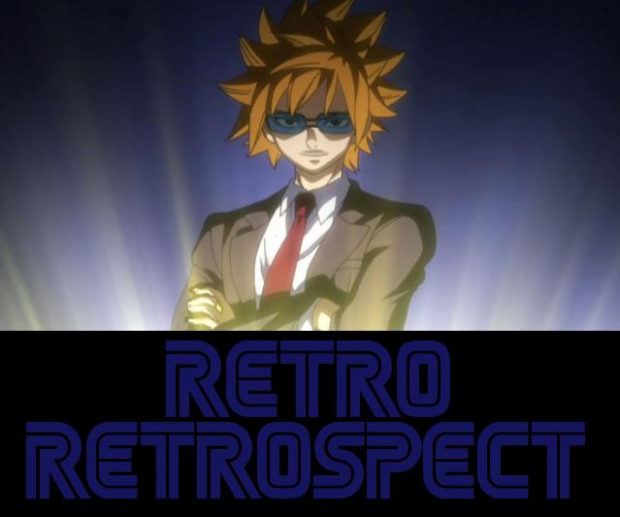Excel Saga is one of the most famous gag anime of all time, a template for every series that followed, but being the first to do something may not have been such a good thing as I shall now explain.

Excel Saga is about Excel, a loyal servant to Lord Ilpalazzo who is trying and failing each episode to takeover the world, each taking place in a certain genre of anime popular at the time. Other stories within this wacky universe include, the mishaps of three civil servants, a Mexican foreign worker's brush with the afterlife and the misadventures of the Director Nabeshin appearing for the first time in animated form. Excel is later joined by Hyatt, a very sickly woman from space and Menchi, a stray dog that becomes an emergency food supply.
Every episode is packed full of gags and reference jokes, except one episode which was purposely made serious. So why the big problem?
It's made in 1999, which is 15 years ago and nearly every relevant joke is lost on today's audience; I am glad that DVD releases carry video notes to explain the references but it's more rewarding to find out yourself.
For example, while some references are easy to point out, like the Fan Service episode and the American episode, there's another ten that won't be, such as the Baseball episode and the Rich Traveling Girl episode.
That's not to say the show is bad, it's actually one of the funniest anime shows of all time and massive respect to the dub actors for the hard work they put in, especially Jessica Calvello who nearly destroyed her voice doing Excel. But sadly this show is lost on today's audience, as it's now become too old to make any sense to the current generation of anime fans.
Excel Saga is in serious need of a reboot and in this era where even Sailor Moon can come back, it's worth looking at again.
Final Verdict: It's a fantastically funny show and deserves a watch, however in this era, it's horribly dated and the gags will be lost on the current Generation of Anime fans.
Throughout my childhood I grew up on Nicktoons much in the same way I grew up on Disney & Cartoon Network, but there were a few gems that I missed mainly because I lost a lot of interest in cartoon channels when they started running out of ideas or thinking that kid sitcoms are worth more money.
One of the gems I missed was Danny Phantom.

Danny Phantom is by Butch Hartman of Fairly Odd Parents fame, which seems to play against type being a superhero cartoon but Hartman seems to manage just fine.
The story is about Danny Fenton, (I see what you did there) an unpopular teenager who attends Casper High School in the town of Amity Park. (Barely into the review and already there are two reference jokes)
Danny's parents are working on a ghost portal to try and bridge the gap between spirit and human worlds when it doesn't work until Danny's friend Sam persuades him to switch on the machine only for Danny's DNA to get fused with Ectoplasm, making him half ghost. After fighting a malevolent ghost, Danny decides to become a superhero in order to stop other evil ghosts, alongside friends Sam and Tucker.
This setup is familiar to anyone who's been watching Kim Possible & American Dragon, as the cartoon is pretty much those shows, only done by Nickelodeon instead of Disney; its another example of Nickelodeon jumping on a current trend but unlike Nicktoons sad ripoff of Regular Show, Sanjay & Craig, Danny Phantom not only works but manages to surpass it's rivals by being original.
In theory the setup shouldn't work, being a half ghost should be impossible even in the most mixed up cartoon world, but credit to Butch Hartman, he does it well.
Even when the most obvious character tropes are used to make up the cast, it's not immediately obvious when viewing the characters on screen.
For example, Sam is essentially Goth Lisa Simpson, but first impressions don't give that image so it makes you want to watch her more, the same can be said about other characters such as Jazz, Tucker and Danny himself.
The action can vary between good and predictable but never becomes boring as the diverse cast of villains can often save a bad episode.
Overall Danny Phantom is a good series bordering on great, it has a well written cast of characters, along side good music and an easy to digest plot. I only wish I viewed it when I did.
You know religion would be a lot cooler if members of the church kicked some serious ass and thanks to Chrono Crusade that's exactly what you get.

The year is 1928, Jazz is King, Bootleg Whiskey flows like water and the nations idle rich have discovered a dangerous new past time. Summoning Devils! To combat this growing threat, a new order of holy warriors have been formed. And their greatest agent is. "Sister Rosette Christopher, Order of Magdalene at your service" "The wet blanket is my assistant Chrono"
I'm sorry I had to do the opening of the old ADV Films Trailer, it's so cheesy and can open a review better than what I can think of.
Anyway, Chrono Crusade takes place in 1920s America at the height of prohibition and there's been a rise in demon activity so Rosette along with Chrono must stop the demons. Chrono is more than a little runt voiced by Greg Ayres, he's actually a demon who made a contract with Rosette who hopes to save her brother Joshua who went mad and petrified everyone after putting on Demon horns. Using a special watch, Rosette gives up her life force to allow Chrono to fight at full power. Rosette is hardly helpless herself having joined the Magdalene order as a nun who can wield guns for exorcism, which is as awesome as it sounds. Not long into the story, Rosette & Chrono come across Azmaria, a young girl who is actually an Apostle, a unique human with holy powers. After saving her, more demons join the equation including a group from Chrono's past.
Chrono Crusade has a great story, it's very good at setting a tone, it's not afraid to pull tearjerkers, drama and comedy in the same episode, similar to what Full Metal Alchemist does.
It's not perfect, there are a number of fight scenes which are poorly edited giving the impression that they constantly ran out of time and rushed the process. Plot twists are a little predictable but on the plus side it's an epic story and top quality dubbing makes it all worthwhile and lets not forget the ending, I won't spoil it but make sure you have a tissue box handy.
Final Verdict: This anime can make you feel everything from sadness to joy and is definitely worth picking up. Dubbing is more effective as it's set in America and doesn't work very well in original Japanese.
Welcome to the A-Z Review season; we first start off with the no comment vote winner, Aoi Sekai no Chuushin De, translated in English as World War Blue. Okay you might think this is an obscure anime title but in reality it contains a lot of well known video game characters in humanoid form. So from the picture below lets introduce you to some of the cast.

So from left to right we have...
Tejirov: Blonde guy with the rod, likes to solve all his problems by filling the gaps with his long rod, he's also a colossal pervert as well as being a genius tactician, he represents Tetris.
Opal: Archery girl, makes bad puns, is an expert archer but later becomes good at shooting energy blasts, she represents Fantasy Zone Opa Opa.
Nel: Young girl with the claw, good at sensing her surroundings and reacting quickly to avoid attacks, based on the same Nel from Phantasy Star II.
Gear: Blue haired shirtless guy, has super speed and is a little angsty, represents Sonic the Hedgehog.
Myomut: Guy with the closed eyes and sweet sword, is a great hero but only says yes and no most of the time, represents Shigeru Miyamoto with the designs of Dragon Quest.
Crystal: Girl behind Myomut, represents Final Fantasy series.
Karvai: Pink haired girl with hammer, very happy girl, represents Kirby.
Zelig: Guy holding the mask and dressed like a samurai, bit of a dick, great at gambling, represents Link from Legend of Zelda.
Marcus: Big guy on the end with the mustache, is actually the villain of this series, represents Mario.
Okay to put the story into summary, this is about the Console Wars of the early 90s told as if it were an actual war and every character is fighting for each company they represent with name changes to protect the properties each character comes from, although for the sake of keeping things simple I will use the names of the characters the cast are based on to describe the plot.
Right at the beginning Sonic's best friend Tails gets killed by soldiers from the Nintendo Empire. Fueled by revenge, Sonic joins the Sega Army and quickly gets placed in a team with other friend Nel and reluctant archer Opa Opa, led by traveling mercenary Tetris.
Meanwhile the Nintendo Empire are having to fight traitors in their own ranks as Sega's rise to power starts creating chaos among the other nations.
Sonic's first mission leads him to Castle Hope in the Taito Nation where he must save Sega's Lead General Alex Kidd, who is later revealed to be Sonic's father; with no chance of saving Alex Kidd, Sonic absorbs his power and proceeds to wipe out the Castle, from there we begin the war in full.
Basically that's the opening from the first two and a half volumes of the manga as well as the short OVA.
So yeah this review is a work in progress and may change at a later date when I eventually finish the series, for now I can honestly say, I want to see where this goes. I especially like the designs chosen for the characters, especially Kirby's character being female, not the only Gender reverse character, Street Fighter's, Fire Emblem's & Pikachu's characters are also female. But overall I like how different they portrayed Sonic, he actually looks like a respectable hero with no arrogance to speak of and that's quite a positive image for a character that badly needs a reboot.
Final Verdict: I really want to see where this series goes, I'm hoping it lives up to my expectations, I wish it were more popular because it's doing a lot of good for these characters.
Welcome to the Endless Wardrobe, my updated news segment to say what's going on in my worlds. Now lets see what's coming up.

Announcing a Special Review Segment
I'll be doing a segment known as the A-Z Review series and you guys can join in by picking the subject each time. You get to pick from an Anime, Game and Cartoon review. Obviously if there are no comments I shall write about something else.
Here is the first list covering "A"
Anime Review: Azumanga Daioh
Cartridge Diaries: Ace Attorney
Cartoon Vault: Archie Weird Mysteries
No Comments: Aoi Sekai no Chushin De
In other World News
Fantasy Zone is still on hiatus but will be back shortly.
Victory Script will conclude it's current segment hopefully this weekend.
Walk of Fame will continue it's current theme.
That's all for now, remember to comment on which review you want next.





